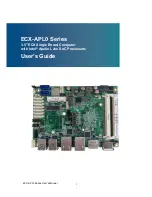
Appendix B
– BIOS & Setup
Dynatem
CPU-111-10 - Intel Xeon Quad-Core 6U VPX SBC – User’s Manual
41
console feature, allowing the user to scrollback through lines previously displayed and
scrolled off the screen. OEMs may configure a set of values, such as 20, 50, 100, 200,
and 500 lines.
Quiet Mode
Enables a feature that causes the Firmbase kernel to suppress its standard messages to
the system console.
Strict Mode
Enables a feature that causes the Firmbase kernel to abort any processes in the system
that make software errors in calling system API functions. Examples include blocking
at IRQLs other than IRQL_THREAD, or passing a NULL pointer to a C library
function that requires a non-NULL pointer, etc.
Disabling this feature causes the kernel to skip over the activity that discovered the
programming error in the application, allowing it to continue if at all possible, with
the consequence that the program may not operate correctly.
B.12
Miscellaneous Setup Menu
The Misc menu provides for configuration of BIOS settings that don’t easily fit in any other category. They include
Cache Control, Keyboard Control, Debugger Settings, and System Monitor Utility Configuration parameters.
The following table presents the settings in the Misc Setup menu:
System Cache
Enables POST’s support for cache in the system. Modern processors virtually require
cache to be enabled to achieve acceptable performance. However, to diagnose certain
problems related to caching in the system, such as multiprocessing systems, it may be
desirable to disable this setting.
Keyboard Numlock LED
Enables the Numlock key when POST initializes the PS/2 keyboard.
Typematic Rate
Specify the rate at which the PS/2 keyboard controller repeats characters when most
keys are pressed down. USB typematic is automatic and does not use this parameter.
Typematic Delay
Specifies the amount of time a repeating key may be pressed on a PS/2 keyboard until
the key repeat feature begins repeating the keystroke. USB typematic is automatic and
does not use this parameter.

























